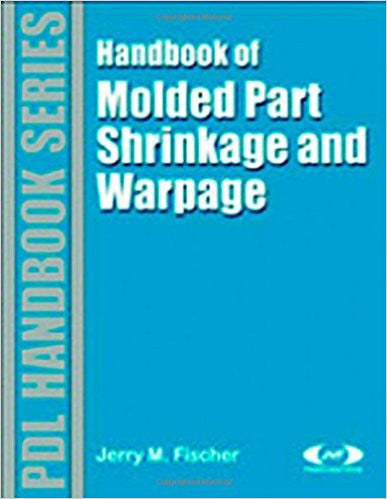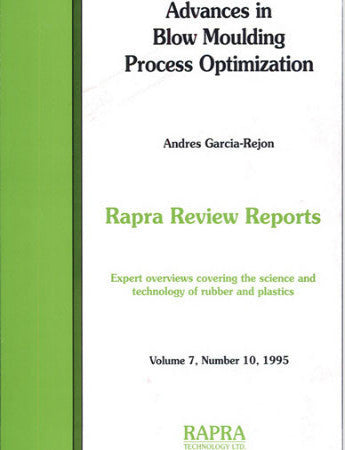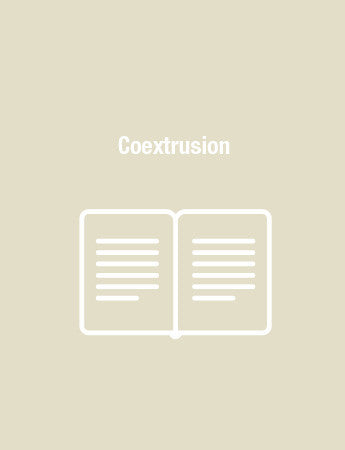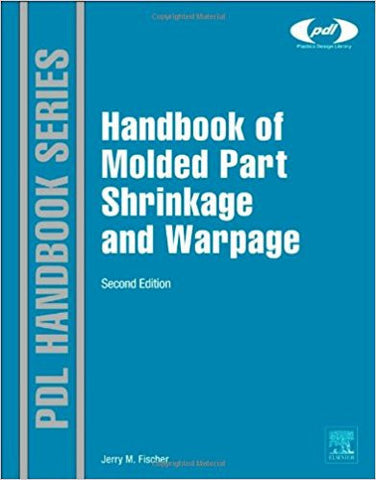Handbook of Molded Part Shrinkage and Warpage
This is the first and only handbook to deal with these fundamental problems.
The handbook explains in plain terms why moldings shrink and warp, shows how additives and reinforcements change the picture, sets out the effects of the molding process conditions, and reveals why you never can have a single "correct" shrinkage value. But, that's not all. The handbook shows you how to alleviate problems by careful design of the molded part and the mold, careful selection of materials, and proper process techniques. It examines computer-aided methods of forecasting shrinkage and warpage. And, most important of all, the handbook provides representative data to work with.
This is the most comprehensive collection of shrinkage data ever compiled in a book and includes hard-to-find multi-point information on how materials, part design, mold design processing, and post mold treatment affect the part's shrinkage and warpage. This book for all people who live and work with mold and shrinkage and warpage.
The handbook explains in plain terms why moldings shrink and warp, shows how additives and reinforcements change the picture, sets out the effects of the molding process conditions, and reveals why you never can have a single "correct" shrinkage value. But, that's not all. The handbook shows you how to alleviate problems by careful design of the molded part and the mold, careful selection of materials, and proper process techniques. It examines computer-aided methods of forecasting shrinkage and warpage. And, most important of all, the handbook provides representative data to work with.
This is the most comprehensive collection of shrinkage data ever compiled in a book and includes hard-to-find multi-point information on how materials, part design, mold design processing, and post mold treatment affect the part's shrinkage and warpage. This book for all people who live and work with mold and shrinkage and warpage.
1. Introduction to Plastics Processing
1.1. Interactivity Basics
1.2. Thermodynamic Principles Governing Injection Molding
1.2.1 Filling
1.2.2 Holding
1.2.3 Cooling
2. Shrinkage and Warpage
2.1 Mold Shrinkage
2.1.1 Determination of Shrinkage
2.1.2 Molded-in Stress
2.2 Warpage
2.2.1 Common Causes of Non-Uniform Shrinkage
2.2.2 principles of Minimizing Warpage
2.3 Post-Mold Shrinkage
3. Causes of Molded Part Variation - Part Design
3.1 Wall Thickness
3.2 Ribs
3.3 Bosses
3.4 Example of Proper Part Design
3.5 Other Design Consideration
4. Causes of Molded Part Variation - Material
4.1 Amorphous and Semi-Crystalline Resins
4.1.1 Amorphous Materials
4.1.2 Semi-Crystalline Materials
4.2 Effects of Fillers, Reinforcements, Pigments, Time and Stress
4.2.1 Effects of Fillers and Fibers
4.2.2 Minimizing the Effects of Fiber Reinforcements
4.2.3 Effects of Pigments
4.2.4 Effects of Time and Stress
4.3 Shrinkage Prediction : Pressure-Volume-Temperature (PVT) Behavior
4.3.1 PVT System Properties
4.3.2 Predicting Mold Shrinkage
4.3.3 Accuracy of Shrinkage Prediction
5. Causes of Molded Part Variation - Mold Design
5.1 Cavity Dimensions and Design Factors
5.2 Gate Types
5.2.1 Sprue Gate
5.2.2 Pin, Pinpoint, Tunnel, and Submarine Gates
5.2.3 Edge and Straight Gates
5.2.4 Fan, Film, Diaphram, Ring, Disk, Cone, and Double-Sided Gates
5.2.5 Multiple Gates
5.3 Gate Location
5.3.1 Side and End gates
5.3.2 Determining Gate Position
5.4 Gate Size
5.5 Gate Design Systems
5.6 Runner Design
5.6.1 Multiple Cavity Molds
5.6.2 Poor Ejection
5.7 Mold Cooling Design
5.7.1 Cooling Channels
5.7.2 Effects of Corners
5.7.3 Thickness Variations
5.7.4 Runnerless Molds
5.7.5 Slides
5.7.6 Venting
5.8 Mold Construction Materials
5.9 Annealing
5.10 Gas Assist
5.11 Pitfalls to Avoid
6. Causes of Molded Part Variation - Processing
6.1 Molding Conditions
6.1 (Injection melt Temperature) - if should be a separate section, renumber as 6.2 and renumber subsequent sections)
6.2 Injection Rate/Pressure
6.2.1 Injection Speed
6.2.2 Injection Pressure
6.3 Holding Pressure/Time
6.3.1 Holding Pressure
6.3.2 Holding pressure Time
6.4 Mold Temperature
6.4.1 Predicting mold Temperature Effects
6.4.2 Relationship Between Mold Temperature and Wall Thickness
6.5 Demolding Temperature
6.6 Molded-in Stresses
7. Factors Affecting Post-Mold Shrinkage
7.1 Effects of Temperatures on Dimensions
7.2 Effects of Moisture on Dimensions
8. How to Control Mold and Post-mold Shrinkage and Warpage
8.1 Find the Cause
8.2 Part Geometry
8.2.1 Overall Part Dimensions
8.2.2 Wall Thickness
8.2.3 Shrinkage Restricting Features
8.3 Material Consideration
8.3.1 Filler or Reinforcement Content
8.3.2 Degree of Moisture Absorption
8.4 Tooling Considerations
8.4.1 Gate Locations
8.4.2 Types and Sizes of Gates
8.4.3 Runner Systems
8.4.4 Mold Cooling Layout
8.4.5 Tool Tolerances
8.4.6 Draft Angles
8.4.7 Ejection system Design
8.4.8 Elastic Deformation of Mold
8.4.9 Mold Wear
8.4.10 Mold Contamination
8.4.11 Position Deviations of Movable Mold Components
8.4.12 Special Issues with Gears
8.5 Processing Considerations
8.5.1 Melt Temperatures and Uniformity
8.5.2 Mold Temperatures and Uniformity
8.5.3 Filling, Packing, and Holding Pressures
8.5.4 Filling, Packing, and Holding Times
8.5.5 Part Temperature at Ejection
8.5.6 Clamp Tonnage
8.5.7 Post-Mold Fixturing/Annealing
8.5.8 Special Problems with Thick Walls and Sink Marks
8.5.9 Nozzles
8.5.10 Excessive or Insufficient Shrinkage
8.5.11 Secondary Machining
8.5.12 Quality Control
8.6 Controlling Warpage
9. Computer Analysis
9.1 How It Works
9.1.1 Assumptions
9.1.2 Generic Elements and Potential Limitations
9.2 Does It Work
9.2.1 Machine Settings and Controls
9.2.2 Different Parts, Different Problems
9.2.3 Differing Capabilities of Software
9.3 What are Realistic Expectations of CAE?
9.4 Resources
9.4.1 How Much Does it Cost?
9.4.2 Consultants
9.5 OR Chapter 9 Appendix: Extended Illustration
10. Case studies
10.1 Unexpected Housing Shrink and Combing of the Glass Fibers
10.2 Changing Materials Triggers Warpage
10.3 Thin-Molded Lids
10.4 Oversize Part Injection Molding Alkyd Thermoset
10.5 Inadequate Mold: Baby Dish
10.6 Gas Entrapment: Baby Dish
10.7 Sprue and Runners
10.8 Spool Mold
10.9 Thermoplastic Engineering Design Study
10.10 CDs
10.11 Flat Parts
10.12 Electronic Connectors
Data
Glossary
Abbreviations
References
Index
1.1. Interactivity Basics
1.2. Thermodynamic Principles Governing Injection Molding
1.2.1 Filling
1.2.2 Holding
1.2.3 Cooling
2. Shrinkage and Warpage
2.1 Mold Shrinkage
2.1.1 Determination of Shrinkage
2.1.2 Molded-in Stress
2.2 Warpage
2.2.1 Common Causes of Non-Uniform Shrinkage
2.2.2 principles of Minimizing Warpage
2.3 Post-Mold Shrinkage
3. Causes of Molded Part Variation - Part Design
3.1 Wall Thickness
3.2 Ribs
3.3 Bosses
3.4 Example of Proper Part Design
3.5 Other Design Consideration
4. Causes of Molded Part Variation - Material
4.1 Amorphous and Semi-Crystalline Resins
4.1.1 Amorphous Materials
4.1.2 Semi-Crystalline Materials
4.2 Effects of Fillers, Reinforcements, Pigments, Time and Stress
4.2.1 Effects of Fillers and Fibers
4.2.2 Minimizing the Effects of Fiber Reinforcements
4.2.3 Effects of Pigments
4.2.4 Effects of Time and Stress
4.3 Shrinkage Prediction : Pressure-Volume-Temperature (PVT) Behavior
4.3.1 PVT System Properties
4.3.2 Predicting Mold Shrinkage
4.3.3 Accuracy of Shrinkage Prediction
5. Causes of Molded Part Variation - Mold Design
5.1 Cavity Dimensions and Design Factors
5.2 Gate Types
5.2.1 Sprue Gate
5.2.2 Pin, Pinpoint, Tunnel, and Submarine Gates
5.2.3 Edge and Straight Gates
5.2.4 Fan, Film, Diaphram, Ring, Disk, Cone, and Double-Sided Gates
5.2.5 Multiple Gates
5.3 Gate Location
5.3.1 Side and End gates
5.3.2 Determining Gate Position
5.4 Gate Size
5.5 Gate Design Systems
5.6 Runner Design
5.6.1 Multiple Cavity Molds
5.6.2 Poor Ejection
5.7 Mold Cooling Design
5.7.1 Cooling Channels
5.7.2 Effects of Corners
5.7.3 Thickness Variations
5.7.4 Runnerless Molds
5.7.5 Slides
5.7.6 Venting
5.8 Mold Construction Materials
5.9 Annealing
5.10 Gas Assist
5.11 Pitfalls to Avoid
6. Causes of Molded Part Variation - Processing
6.1 Molding Conditions
6.1 (Injection melt Temperature) - if should be a separate section, renumber as 6.2 and renumber subsequent sections)
6.2 Injection Rate/Pressure
6.2.1 Injection Speed
6.2.2 Injection Pressure
6.3 Holding Pressure/Time
6.3.1 Holding Pressure
6.3.2 Holding pressure Time
6.4 Mold Temperature
6.4.1 Predicting mold Temperature Effects
6.4.2 Relationship Between Mold Temperature and Wall Thickness
6.5 Demolding Temperature
6.6 Molded-in Stresses
7. Factors Affecting Post-Mold Shrinkage
7.1 Effects of Temperatures on Dimensions
7.2 Effects of Moisture on Dimensions
8. How to Control Mold and Post-mold Shrinkage and Warpage
8.1 Find the Cause
8.2 Part Geometry
8.2.1 Overall Part Dimensions
8.2.2 Wall Thickness
8.2.3 Shrinkage Restricting Features
8.3 Material Consideration
8.3.1 Filler or Reinforcement Content
8.3.2 Degree of Moisture Absorption
8.4 Tooling Considerations
8.4.1 Gate Locations
8.4.2 Types and Sizes of Gates
8.4.3 Runner Systems
8.4.4 Mold Cooling Layout
8.4.5 Tool Tolerances
8.4.6 Draft Angles
8.4.7 Ejection system Design
8.4.8 Elastic Deformation of Mold
8.4.9 Mold Wear
8.4.10 Mold Contamination
8.4.11 Position Deviations of Movable Mold Components
8.4.12 Special Issues with Gears
8.5 Processing Considerations
8.5.1 Melt Temperatures and Uniformity
8.5.2 Mold Temperatures and Uniformity
8.5.3 Filling, Packing, and Holding Pressures
8.5.4 Filling, Packing, and Holding Times
8.5.5 Part Temperature at Ejection
8.5.6 Clamp Tonnage
8.5.7 Post-Mold Fixturing/Annealing
8.5.8 Special Problems with Thick Walls and Sink Marks
8.5.9 Nozzles
8.5.10 Excessive or Insufficient Shrinkage
8.5.11 Secondary Machining
8.5.12 Quality Control
8.6 Controlling Warpage
9. Computer Analysis
9.1 How It Works
9.1.1 Assumptions
9.1.2 Generic Elements and Potential Limitations
9.2 Does It Work
9.2.1 Machine Settings and Controls
9.2.2 Different Parts, Different Problems
9.2.3 Differing Capabilities of Software
9.3 What are Realistic Expectations of CAE?
9.4 Resources
9.4.1 How Much Does it Cost?
9.4.2 Consultants
9.5 OR Chapter 9 Appendix: Extended Illustration
10. Case studies
10.1 Unexpected Housing Shrink and Combing of the Glass Fibers
10.2 Changing Materials Triggers Warpage
10.3 Thin-Molded Lids
10.4 Oversize Part Injection Molding Alkyd Thermoset
10.5 Inadequate Mold: Baby Dish
10.6 Gas Entrapment: Baby Dish
10.7 Sprue and Runners
10.8 Spool Mold
10.9 Thermoplastic Engineering Design Study
10.10 CDs
10.11 Flat Parts
10.12 Electronic Connectors
Data
Glossary
Abbreviations
References
Index
Jerry Fischer, CEO of Tools and Troubleshooting, Inc., brings to this handbook over 35 years experience as a mold designer and builder and consultant on mold shrinkage and warpage conditions. In the 1980s, Jerry published two books with McGraw-Hill on computer-aided design.




